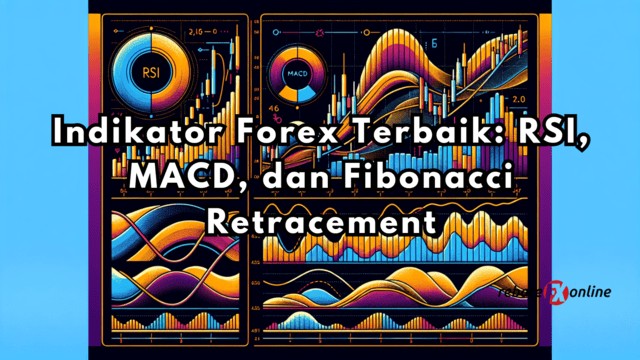Forex trading requires a combination of skills, knowledge, and tools to navigate the volatile currency markets effectively. Among these tools, technical indicators play a pivotal role in analyzing market trends, identifying potential entry and exit points, and making informed decisions. This article explores three of the most widely used indicators in forex trading: RSI, MACD, and Fibonacci Retracement.
1. Relative Strength Index (RSI)
What is RSI?
The Relative Strength Index (RSI) is a momentum oscillator that measures the speed and change of price movements. It was developed by J. Welles Wilder and is represented on a scale from 0 to 100. RSI helps traders determine whether a currency pair is overbought or oversold, which could signal potential reversals.
How to Use RSI:
- Overbought and Oversold Levels: An RSI above 70 typically indicates overbought conditions, suggesting a potential price correction or reversal. Conversely, an RSI below 30 signals oversold conditions, indicating a potential upward movement.
- Divergences: RSI divergences occur when the price moves in the opposite direction of the RSI. For instance, if the price creates higher highs while RSI forms lower highs, it could indicate weakening momentum and a possible reversal.
- Trend Confirmation: During strong trends, the RSI may remain overbought or oversold for extended periods. Traders use RSI to confirm the strength of a trend rather than solely relying on overbought/oversold signals.
Practical Example:
Imagine the EUR/USD pair has an RSI of 75. This suggests the pair is overbought, and traders may look for signs of a reversal, such as bearish candlestick patterns or a decline in volume.
2. Moving Average Convergence Divergence (MACD)
What is MACD?
The Moving Average Convergence Divergence (MACD) is a trend-following indicator that shows the relationship between two moving averages of a currency pair’s price. Created by Gerald Appel, MACD is composed of three components:
- The MACD Line: The difference between the 12-period and 26-period Exponential Moving Averages (EMAs).
- The Signal Line: A 9-period EMA of the MACD line.
- The Histogram: Represents the difference between the MACD line and the signal line.
How to Use MACD:
- Crossover Signals: When the MACD line crosses above the signal line, it generates a bullish signal, suggesting it might be a good time to buy. Conversely, when the MACD line crosses below the signal line, it indicates a bearish signal.
- Histogram Analysis: The histogram’s size and direction indicate the strength and momentum of the trend. A growing histogram suggests increasing momentum, while a shrinking one signals weakening momentum.
- Divergences: Similar to RSI, MACD divergences between the price and the indicator can hint at potential reversals.
Practical Example:
If the MACD line crosses above the signal line while the histogram turns positive, it may signal a buying opportunity for the GBP/USD pair during an upward trend.
3. Fibonacci Retracement
What is Fibonacci Retracement?
Fibonacci Retracement is a tool based on the mathematical sequence introduced by Leonardo Fibonacci. It identifies potential support and resistance levels by dividing vertical distances between significant price points into key Fibonacci ratios: 23.6%, 38.2%, 50%, 61.8%, and 78.6%.
How to Use Fibonacci Retracement:
- Identifying Support and Resistance: Traders use Fibonacci levels to predict where the price might retrace before continuing in the original trend.
- Combining with Other Indicators: Fibonacci Retracement works best when used alongside other technical indicators, such as RSI or MACD, to confirm potential entry or exit points.
- Trend Trading: During an uptrend, traders look for retracement levels to act as support, while in a downtrend, these levels often act as resistance.
Practical Example:
Suppose the USD/JPY pair is in a strong uptrend, and traders use the Fibonacci tool to measure the retracement from a recent low to a high. If the price retraces to the 61.8% level and RSI confirms oversold conditions, it could signal a buying opportunity.
Combining RSI, MACD, and Fibonacci Retracement
While each of these indicators is powerful individually, their true potential lies in combining them to strengthen trading strategies. For example:
- Use RSI to identify overbought or oversold conditions.
- Confirm the trend direction or potential reversal with MACD crossovers or divergences.
- Pinpoint entry and exit levels using Fibonacci Retracement.
Example:
A trader analyzing the AUD/USD pair notices:
- RSI shows oversold conditions at 25.
- MACD histogram turns positive, signaling bullish momentum.
- The price is testing the 50% Fibonacci retracement level after a significant decline.
This confluence of signals suggests a potential buying opportunity with a well-defined risk-to-reward ratio.
Final Thoughts
RSI, MACD, and Fibonacci Retracement are essential tools in a forex trader’s toolkit. They provide valuable insights into market trends, momentum, and potential turning points. However, no indicator guarantees success, and traders should combine these tools with sound risk management, a solid trading plan, and continuous learning to achieve consistent results in the forex market.

